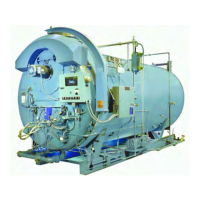Chapter 3 — Waterside Care and Requirements
Part No. 750-184 3-3
A temperature of 170°F is also recommended in order to provide a
sufficient “temperature head” when No. 6 fuel oil is to be heated to
the proper atomizing temperature by the boiler water in a safety-
type oil preheater. (The electric preheater on the boiler must provide
additional heat to the oil if boiler water temperature is not
maintained above 200°F. )
Note: If the operating water temperature going to the system must
be lower than 170
°
F, the operating boiler water temperature
should be a minimum of 170
°
F (200
°
F if used to preheat No.
6 oil) and mixing valves should be used to avoid damage to
the equipment.
Rapid Replacement of Boiler Water - The system layout and
controls should be arranged to prevent the possibility of pumping
large quantities of cold water into a hot boiler, which will cause
shock or thermal stresses. Water temperature in a boiler of 200°F
or 240°F cannot be completely replaced with 80°F water in a few
minutes time without causing thermal stress. The same fact applies
to periods of normal operation, as well as during initial start-up.
Note: The circulating pumps should be interlocked with the burner
so that the burner cannot operate unless the circulating pump
is running in order to avoid damage to the equipment.
When individual zone circulating pumps are used, it is
recommended that they be kept running-even though the heat users
do not require hot water. The relief device or by-pass valve will thus
allow continuous circulation through the boiler and can help prevent
rapid replacement of boiler water with cold zone water.
Continuous Flow Through the Boiler - The system should be piped
and the controls arranged to allow water circulation through the
boiler under all operating conditions. The operation of three-way
valves and system controls should be checked to be sure that the
boiler will not be by-passed. Constant circulation through the boiler
eliminates the possibility of stratification within the unit and results
in more even water temperatures to the system.
A rule of thumb of 3/4 to 1 gpm per boiler horsepower can be used
to determine the minimum continuous flow rate through the boiler
under all operating conditions. The operator should determine that
a flow of water exists through the boiler before initial firing or refiring
after boiler has been drained.
Water Circulation
Table 3-1 shows the maximum gpm circulation rate of boiler water
in relation to full boiler output and system temperature drop.
Multiple Boiler Installations - When multiple boilers are used, care
must be taken to ensure adequate or proportional flow through the
boilers. Proportional flow can best be accomplished by use of
balancing valves and gauges in the supply line from each boiler. If
balancing valves or orifice plates are used, a significant pressure
drop (e.g., 3-5 psi) must be taken across the balancing device to
accomplish the purpose.

